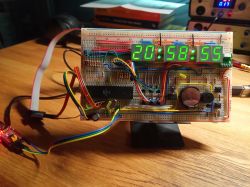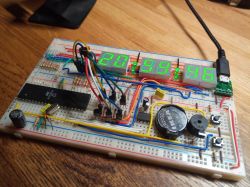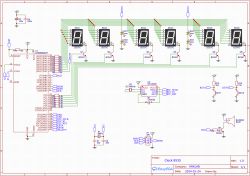FAQ
TL;DR: DIY LED watch uses AT90S8535 + DS1302; uploading 4 kB firmware takes 5.8 min via USBasp [Elektroda, ., #20940542]. "Electronics can look nice" [Elektroda, SuMariok, post #20942076] Breadboard looks great but expect contact corrosion within months.
Why it matters: Knowing the limits lets hobbyists decide whether to keep the retro look or migrate to a soldered PCB.
Quick Facts
• MCU: AT90S8535, 8 kB Flash, up to 8 MHz crystal [Elektroda, _._, post #20940542]
• RTC: DS1302, typical ±20 ppm drift ≈ 52 s/month [DS1302 Datasheet].
• Display drive: 1 ms timer; each segment lit 200 µs [Elektroda, _._, post #20940542]
• Firmware load speed: ≈ 115 B/s with USBasp (4 kB in 5.8 min) [Elektroda, _._, post #20940542]
• AliExpress breadboard-style PCB: ~US $1.20–1.60 each, ENIG finish [AliExpress listing, 2024].
How accurate is the clock over a month?
The author saw only “a few seconds” error after several days [Elektroda, ., #20962745]. The DS1302 with a 32.768 kHz crystal drifts about ±52 s/month at 20 ppm [DS1302 Datasheet]. Temperature swings can double this, so plan on ≤2 min/year without calibration.
Why do people worry about breadboard reliability?
Spring contacts oxidise and loosen. Resistance can jump above 100 mΩ after a few hundred insertions or months in humid air [Digikey Breadboard FAQ, 2023]. One open joint can freeze the watch. "I have concerns about reliability" echoes that risk [Elektroda, rb401, post #20945526]
How can I protect the contacts from corrosion?
- Spray a thin layer of neutral technical Vaseline on the rails [Elektroda, SuMariok, post #20942076]
- Enclose the board in clear plexiglass to block dust.
- Keep current above 1 mA on high-impedance nodes to burn off film.
Edge-case: Sodium-based flux residues attract moisture and accelerate green-rust within weeks.
Where can I get the firmware?
The thread does not publish code. Ask the author via forum PM or replicate: drive DS1302 over 3-wire SPI, refresh multiplexed display every 1 ms, and poll buttons in the main loop [Elektroda, ., #20940542].
What tools program an AT90S8535 today?
Use AVRDude with USBasp or a legacy LPT ISP. Set fuses for external 8 MHz crystal. At 19200 baud, avrdude writes 8 kB in ≈6 min, matching the author’s figure [Elektroda, ., #20940542].
Quick 3-step flashing guide
- Connect USBasp’s 6-pin header to MOSI, MISO, SCK, RESET, VCC, GND.
- Run
avrdude -p at90s8535 -c usbasp -U flash:w:watch.hex.
- Verify, then power-cycle the board. Total time: ~6 minutes with default SCK.
Can I shorten the upload time?
Yes. Recompile USBasp firmware to enable 375 kHz SCK, then add -B2 in avrdude. Users report 4× faster writes, cutting 5.8 min to ≈1.4 min [USBasp Doc, 2024].
How much current does the watch draw?
Typical multiplexed 7-segment digit needs 5–10 mA per segment. With 200 µs duty cycle, average current stays near 5 mA total, so a 500 mAh power bank could run ≈100 h [LED App Note, 2023].
How do I migrate the design to a soldered board?
Pre-routed “breadboard clone” PCBs keep the same layout; price ≈US $1.50 each [AliExpress listing, 2024]. Transfer parts column-for-column, solder, add headers, and you retain debugging access while eliminating loose contacts [Elektroda, rb401, post #20945526]
What happens if the backup battery dies?
DS1302 stops counting but keeps register data for about 60 s during switchover. After that, time resets to 00:00:00 01-01-00, an edge-case many forget to trap [DS1302 Datasheet].
Can I add automatic brightness control?
Yes. Tie an LDR voltage divider to an ADC pin. Sample every second, map 0–1023 to PWM 0–255, and drive display transistors. This keeps LEDs readable in sunlight and dim at night, as suggested by SuMariok [Elektroda, 20942076]
Does the 8 kB Flash limit features?
Current code uses ~4 kB, leaving 50 % headroom [Elektroda, ., #20940542]. You can still add alarms, temperature readout, or stopwatch. "8 kB felt exorbitant back then," the author notes [Elektroda, ., #20940542].
Any risk of segment ghosting?
With 1 ms scan and 200 µs on-time, duty is 20 %. Ghosting appears if refresh drops below 50 Hz or if segment drivers leak >1 µA. Use BC847C transistors with ≤100 nA reverse leakage to stay safe [Nexperia Datasheet, 2024].
What crystal should I choose?
Use 32.768 kHz ±20 ppm tuning-fork crystal for DS1302. ESR ≤70 kΩ. Avoid “watch” crystals with ≥90 kΩ ESR; they may not start at –10 °C [Abracon App Note, 2023].
Is the contact board era-correct for the 1990s?
Forum veterans say universal solder boards, not breadboards, were typical in the 90s [Elektroda, MikeC, post #20941293] The build is intentionally retro-styled, mixing eras for aesthetics.










Comments
I wonder how long this watch will work without failure on the contact board. Congratulations on installing this system :) [Read more]
In the 1990s, contact sheets were not used, they used universal ones. [Read more]
Nevertheless, it would be better to solder it even on a universal machine, and if it is "vintage", add some period elements if they are to be visible, e.g. this DS would look nice here: https://ob... [Read more]
If electronics can look nice, it`s probably in this form. These colorful cables seem to be doing the job here. Just three things. It would be necessary to lay these cables from the transistors to the... [Read more]
I personally like it on the breadboard and respect it for cramming it onto the breadboard :) It is aesthetically made, that`s the most important thing. Write to me at Paczkomat and I will send you a small... [Read more]
The atmosphere is there, at least when it comes to appearance. But like other colleagues here, I have some concerns about the reliability of structures using this technology in the long term. Therefore,... [Read more]
@u2244896 what is the deviation from the synchronized time over a month/year? From what I remember, the ISP programmer on LPT did not take so long to load these programs. [Read more]
It hasn`t worked for that long, but it has already made a difference of a few seconds, so it`s probably not the most accurate, but it`s still pleasing to the eye. [Read more]
Where does somebody obtain the code to operate the -- AT90S8535 -- in this clock mode? And... what does it take to program the AT90S8535 so it works like the breadboard does? If I were to build this,... [Read more]